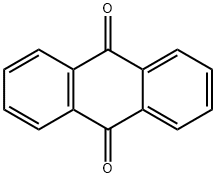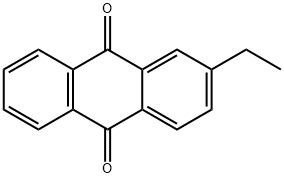Anthraquinone , Analysis standard , 84-65-1
Synonym(s):
9,10-Dihydro-9,10-anthracenedione;Anthraquinone;ATQ
CAS NO.:84-65-1
Empirical Formula: C14H8O2
Molecular Weight: 208.21
MDL number: MFCD00001188
EINECS: 201-549-0
| Pack Size | Price | Stock | Quantity |
| 250MG | RMB159.20 | In Stock |
|
| others | Enquire |
PRODUCT Properties
| Melting point: | 284-286 °C (lit.) |
| Boiling point: | 379-381 °C (lit.) |
| Density | 1.438 |
| bulk density | 600kg/m3 |
| vapor density | 7.16 (vs air) |
| vapor pressure | 1 mm Hg ( 190 °C) |
| refractive index | 1.5681 (estimate) |
| Flash point: | 365 °F |
| storage temp. | no restrictions. |
| solubility | 0.00007g/l |
| form | Powder |
| color | Yellow-green to khaki to tan |
| Water Solubility | <0.1 g/100 mL at 23 ºC |
| Merck | 14,687 |
| BRN | 390030 |
| Stability: | Stable. Incompatible with strong oxidizing agents. Combustible. |
| InChIKey | RZVHIXYEVGDQDX-UHFFFAOYSA-N |
| LogP | 3.39-3.4 at 30℃ |
| CAS DataBase Reference | 84-65-1(CAS DataBase Reference) |
| IARC | 2B (Vol. 101) 2013 |
| NIST Chemistry Reference | 9,10-Anthraquinone(84-65-1) |
| EPA Substance Registry System | Anthraquinone (84-65-1) |
Description and Uses
Anthraquinone is a combustible, light yellowto green crystalline solid. Molecular weight= 208.23;Boiling point= 380℃; Melting/Freezing point= 286℃(sublimes); Flash point= 185℃ (cc). NFPA 704 M HazardIdentification (based on NFPA-704 M Rating System):Health 0, Flammability 1, Reactivity 0. Very slightly solublein water; solubility=,13 mg/L at 22℃.
Anthraquinone is used in paper industry as a catalyst to increase the pulp production yield and to improves the fiber strength through reduction reaction of cellulose to carboxylic acid. It is also used as a precursor for dye formation.
Safety
| Symbol(GHS) |   GHS07,GHS08 |
| Signal word | Danger |
| Hazard statements | H317-H350 |
| Precautionary statements | P202-P261-P272-P280-P302+P352-P308+P313 |
| Hazard Codes | Xi |
| Risk Statements | 43-36/37/38 |
| Safety Statements | 36/37-37/39-26-24 |
| RIDADR | 3077 |
| WGK Germany | 1 |
| RTECS | CB4725000 |
| Autoignition Temperature | 650 °C |
| TSCA | Yes |
| HS Code | 2914 61 00 |
| HazardClass | 9 |
| PackingGroup | III |
| Hazardous Substances Data | 84-65-1(Hazardous Substances Data) |
| Toxicity | LD50 orally in Rabbit: > 5000 mg/kg |


